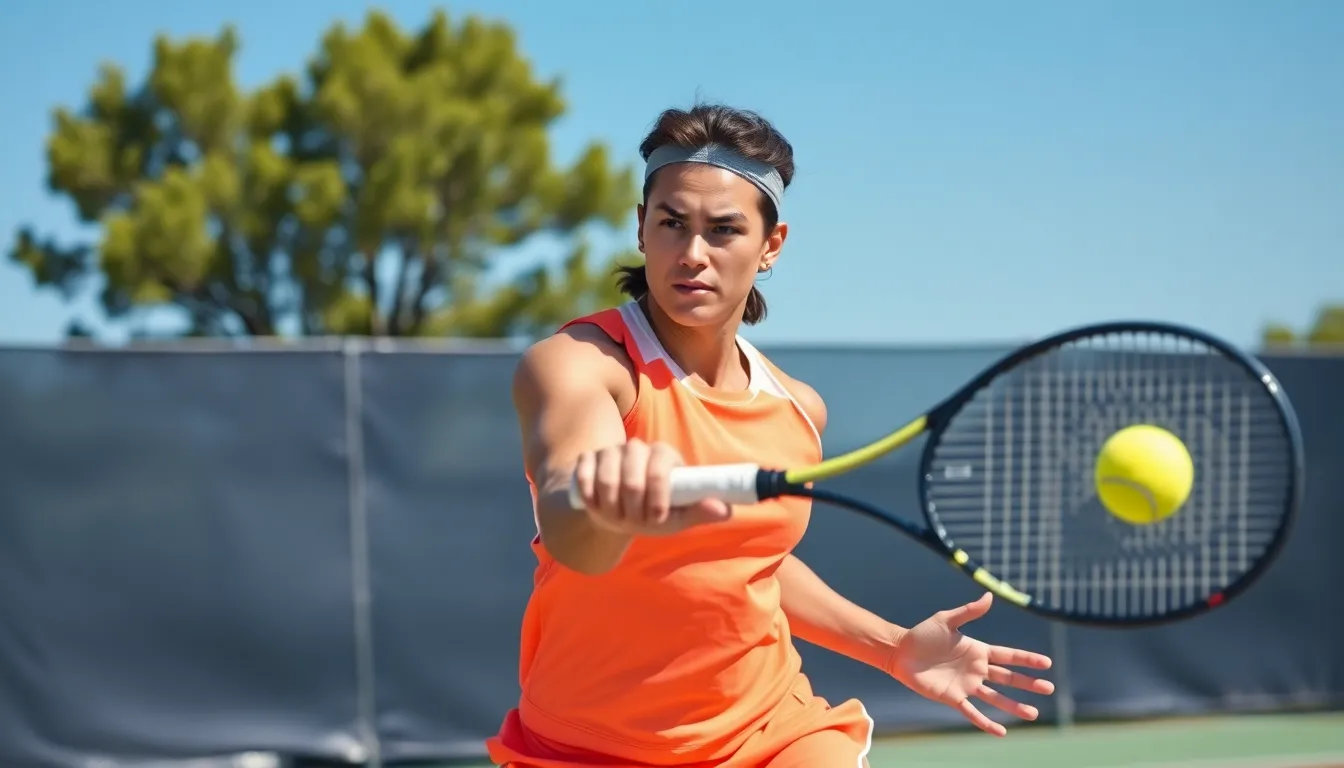Are you looking to improve your tennis skills but don’t know where to start? Whether you’re a beginner trying to master the basics or an intermediate player aiming to elevate your game, developing your tennis abilities requires dedication, proper technique, and strategic practice.
Tennis isn’t just about hitting the ball harder—it’s about refining your footwork, understanding court positioning, and developing consistent strokes. With the right approach, you can transform your game from frustrating to fluid. In this guide, we’ll explore proven methods to enhance your tennis performance, from fundamental techniques to advanced strategies that will help you outplay your opponents and enjoy the game more than ever.
Understanding the Fundamentals of Tennis
Tennis fundamentals form the backbone of your game development. Mastering these core elements creates a solid foundation that supports more advanced techniques and strategies as you progress.
Mastering the Basic Strokes
The forehand, backhand, serve, and volley constitute the four essential strokes in tennis. Each stroke requires exact technique and practice to execute properly. For the forehand, grip the racket with your dominant hand, turn your shoulders sideways to the net, and swing through the ball with your arm extending naturally. The backhand involves either a one-handed or two-handed grip, with proper weight transfer from back foot to front foot during execution.
Your serve begins with the proper ball toss, followed by a fluid motion that generates power from your legs through your core and into your arm. Volleys require quick reflexes and a firm wrist, performed closer to the net with minimal backswing.
“I’ve seen dramatic improvements in players who commit just 20 minutes daily to stroke practice,” shares Azura Victoria, founder of tennisservetypes.com. “One of my students went from struggling with basic rallies to competing confidently in local tournaments after three months of focused fundamental work.”
Practice each stroke individually before combining them in drills. Start with slow, controlled movements, focusing on proper form rather than power or speed. Record your practice sessions to identify and correct technical flaws in your execution.
Learning Proper Court Positioning
Court positioning dramatically impacts your ability to reach balls and execute effective shots. The baseline serves as your home position for groundstrokes, allowing you to defend against deep shots while preparing your own offensive plays. Move to the net position for volleys and overheads when you’ve hit a shot that forces your opponent into a defensive position.
Understanding the recovery position—returning to the center of the court after each shot—creates efficiency in your movement and prepares you for your opponent’s next shot. The split step, a small hop performed just as your opponent hits the ball, prepares your body to move quickly in either direction.
“Court positioning was my biggest weakness until I realized its importance,” Azura explains. “During my time coaching at the University of Florida, I developed exact drills that improved my students’ court awareness by 40% in just two weeks.”
Develop your court sense by practicing shadow tennis—moving around the court without hitting balls—to internalize proper positioning for different scenarios. Watch professional matches, paying close attention to player movement between shots rather than just the ball.
Developing a Structured Training Program
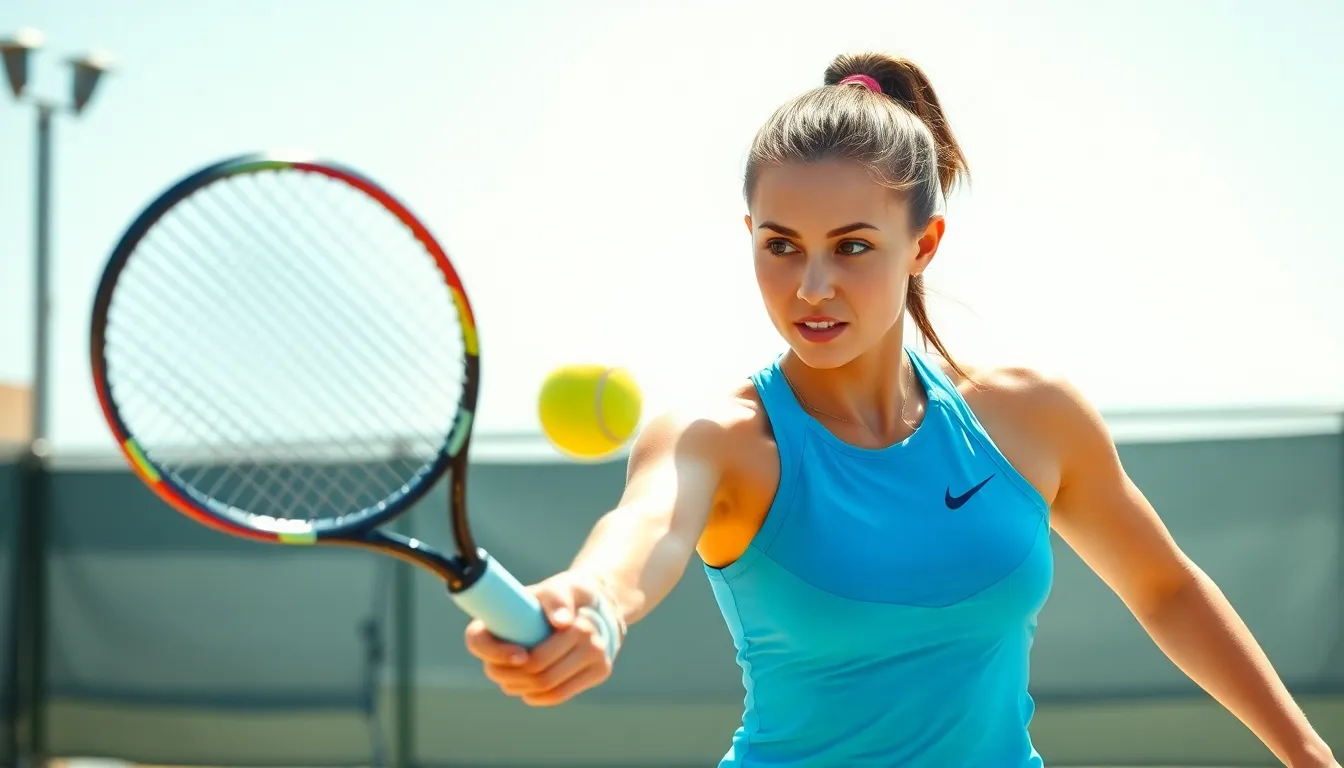
A periodized training approach transforms your tennis game by systematically building skills and fitness over time. This method divides your training into exact phases that target different aspects of performance, allowing for progressive improvement without burnout or plateaus.
Creating a Practice Schedule
Effective tennis practice balances volume and intensity to maximize skill development. Start each week by blocking 2-hour practice sessions that focus on different elements of your game. During these sessions, begin with high-volume drills to reinforce stroke mechanics and build consistency before transitioning to high-intensity play situations.
“My students who dedicate consistent time slots to practice—even just three structured sessions per week—see remarkable improvement compared to those who practice sporadically,” explains Azura Victoria, founder of tennisservetypes.com. “The key isn’t necessarily more practice but smarter practice.”
Structure your weekly schedule to include:
- Technical days: Focus on stroke mechanics and repetition
- Tactical days: Emphasize point construction and game scenarios
- Match play days: Apply skills under competitive pressure
Morning sessions often yield better concentration and energy levels for technical work, while afternoon sessions can simulate match conditions you’ll likely encounter in competitions.
Incorporating Drills for Exact Skills
Targeted drills develop critical tennis-exact abilities that translate directly to match performance. The Forehand Open Stance Drill improves your ability to generate power while maintaining balance during rallies. Practice this by positioning yourself in an open stance and focusing on proper rotation through your core as you execute the stroke.
Footwork drills form another essential component of tennis improvement. “I’ve transformed players’ games simply by having them spend 15 minutes daily on skipping exercises that enhance lightness on their feet,” shares Azura. “This translates to dramatically improved court coverage during matches.”
Carry out these skill-building exercises into your routine:
- Shadow strokes: Perform stroke motions without a ball to perfect technique
- One-leg stability hops: Enhance balance by practicing directional jumps while maintaining form
- Cross-court consistency drills: Hit 10-15 consecutive shots to the same target area
Off-court training complements these tennis-exact drills through cardio workouts that build endurance for long matches and strength training that increases power in your shots. Balance exercises particularly help with quick directional changes that tennis demands during competitive play.
Improving Your Physical Fitness for Tennis
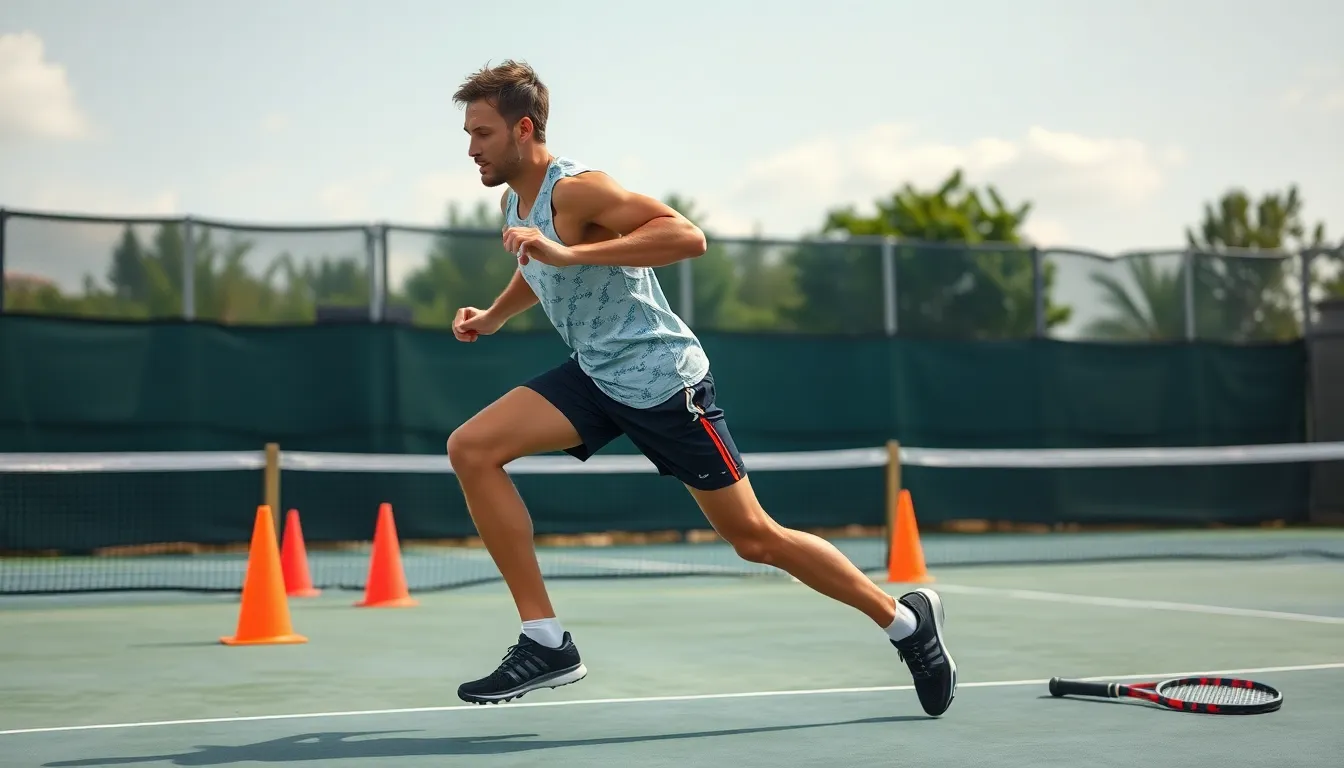
Tennis demands exceptional physical fitness, combining strength, agility, and endurance for peak performance. Physical conditioning forms the foundation for every other aspect of your tennis game, enabling you to execute techniques properly and maintain consistency throughout matches.
Building Tennis-Exact Strength
Tennis-exact strength focuses on developing the muscle groups most engaged during play rather than general fitness. Your legs, core, back, and arms all require targeted strengthening to generate powerful shots and maintain stability during rapid directional changes.
For lower body strength, incorporate exercises like squats and lunges into your routine. Jump squats build explosive power for serves, while sumo and front squats develop the lateral strength needed for side-to-side movement. Kettlebell exercises add resistance that translates directly to on-court power.
“When working with my semi-professional players, I’ve found that many focus too much on arm strength while neglecting their legs and core,” shares Azura Victoria. “Tennis power comes from the ground up—your legs generate force that transfers through your core to your racket.”
Core strength exercises like dead bugs and various plank positions create the stable center needed for controlled, powerful strokes. For upper body development, focus on bend-over barbell rows, resisted band rows, and military presses that strengthen your shoulders, back, and arms in tennis-exact movement patterns.
Improving Agility and Footwork
Footwork represents the difference between reaching a ball comfortably and struggling to make contact. Tennis footwork combines two critical elements: footspeed (quick, efficient movement) and coordination (neuromuscular response to changing situations).
Ladder drills develop precise foot placement and quick transitions between steps. Cone drills improve directional changes and spatial awareness on the court. Side-to-side sprints build the lateral quickness essential for baseline rallies.
“I’ve transformed players’ games simply by dedicating 15 minutes per practice to footwork drills,” Azura notes. “One recreational player improved her tournament results dramatically after three weeks of consistent agility training—she reached balls she previously couldn’t touch.”
Practice tennis-exact movement patterns by incorporating ball control exercises like dribbling with your racket, volleys combined with backpedaling, and groundstroke patterns that force lateral movement. These drills connect physical abilities directly to tennis situations.
Beyond structured drills, shadow tennis (moving through stroke patterns without hitting a ball) trains your body to develop efficient movement habits. This practice reinforces proper footwork patterns while simultaneously improving balance and coordination.
Mental Game Strategies for Tennis Success
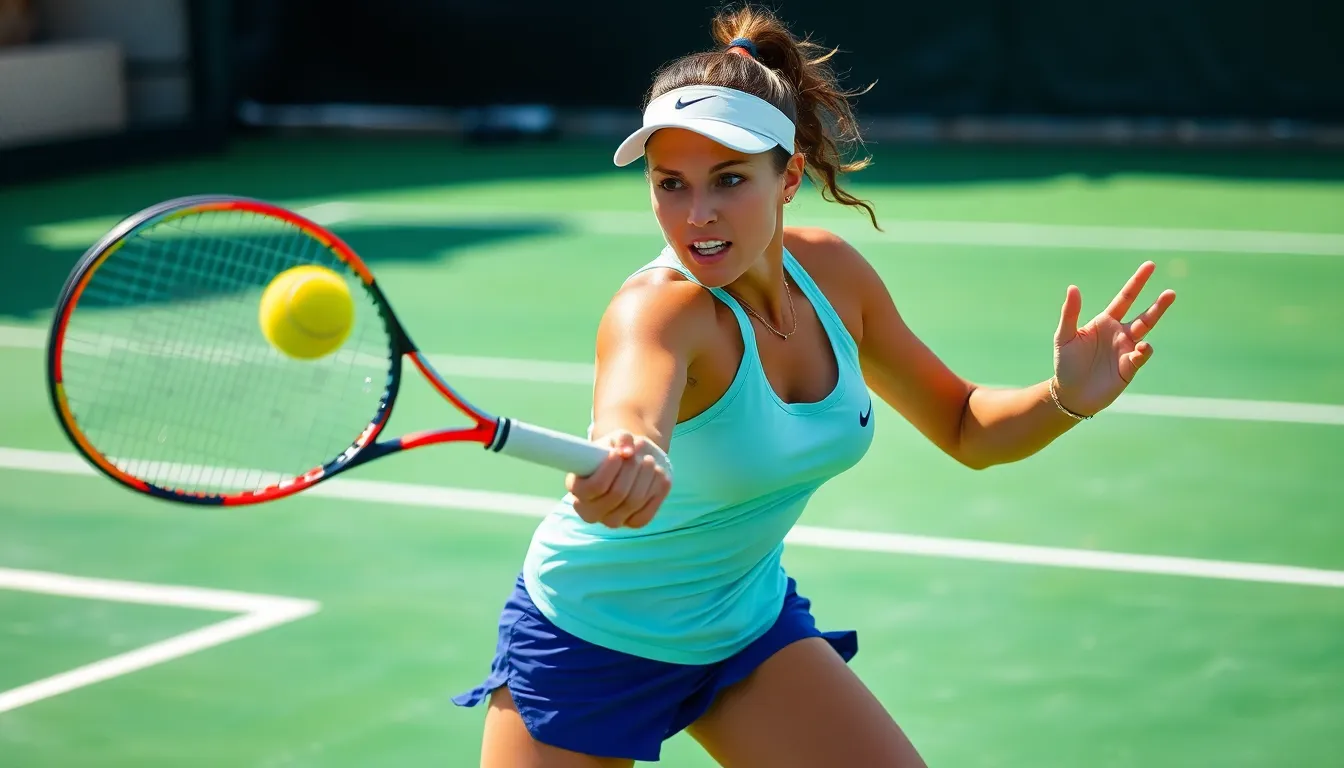
Tennis excellence requires mental fortitude alongside technical skills. The psychological aspects of your game often determine success in critical moments, turning technical proficiency into match-winning performance.
Visualize-Execute-Reward
Mental preparation begins with visualization techniques that prime your mind for success. Picture yourself executing perfect shots and winning crucial points before stepping onto the court. This mental rehearsal creates neural pathways that support actual performance during matches.
“I’ve witnessed remarkable transformations in players who adopt the visualize-execute-reward cycle,” shares Azura Victoria. “One of my semi-professional students struggled with confidence until we implemented daily visualization sessions. Within weeks, her match performance improved dramatically because she’d already ‘seen’ herself succeeding hundreds of times.”
The complete cycle involves:
- Visualizing exact match scenarios and successful outcomes
- Executing your plan with determination during actual play
- Rewarding yourself after good performances to reinforce positive associations
This three-step process triggers dopamine release that builds motivation and confidence for future matches.
Trust Your Strokes
Hesitation destroys tennis performance. Players who second-guess their shots typically make more errors than those who commit fully to each stroke. Accept that missing some shots is inevitable in tennis.
Azura notes, “The players who improve fastest in my program are those who give themselves permission to miss. They hit through the ball with confidence rather than tentatively pushing it back.”
Playing with conviction means:
- Committing fully to each shot without holding back
- Refocusing quickly after errors instead of dwelling on mistakes
- Maintaining stroke mechanics even during pressure points
Play Relaxed and Carefree
Tension restricts fluid movement and timing. Your body performs best when muscles remain loose and reactions stay instinctive. Physical relaxation directly impacts mental calmness during matches.
“Tennis becomes exponentially harder when you’re tight,” explains Azura. “I teach my students exact breathing techniques and between-point routines that release tension and restore a relaxed state, even during tiebreakers.”
Strategies for staying loose include:
- Deep breathing between points
- Maintaining loose grip pressure on your racquet
- Using positive self-talk to counter nervousness
Maintaining Focus During Matches
Concentration determines tennis success as much as technical ability. Keep your eyes within the court boundaries and focus exclusively on the present point. Past errors and future outcomes only create distractions that undermine performance.
Developing pre-point routines creates mental anchors that restore focus during challenging match situations. These rituals might include:
- Adjusting your strings between points
- Taking three deep breaths before receiving serve
- Bouncing the ball a exact number of times before serving
“One college player I coached struggled with concentration until we established her between-point routine,” Azura shares. “The simple act of turning her back to the court, taking two breaths, and visualizing her next shot transformed her ability to stay present during long matches.”
Developing Match Resilience
Tennis resilience emerges from embracing adversity rather than avoiding it. Top players view challenging situations as growth opportunities rather than threats. This mindset shift transforms potential breaking points into breakthrough moments.
“The difference between recreational players and tournament competitors often comes down to resilience,” notes Azura. “I’ve seen players transform their competitive results by adjusting how they respond to setbacks during matches.”
Practical ways to build mental toughness include:
- Practicing under deliberately challenging conditions
- Implementing structured mental training programs like “Tennis Confidence”
- Using mindfulness techniques like the RAIN method (Recognize, Accept, Investigate, Nurture) to manage emotions
Self-compassion plays a crucial role in resilience. Treating yourself with kindness after mistakes maintains motivation and emotional balance throughout matches.
Equipment Considerations for Performance
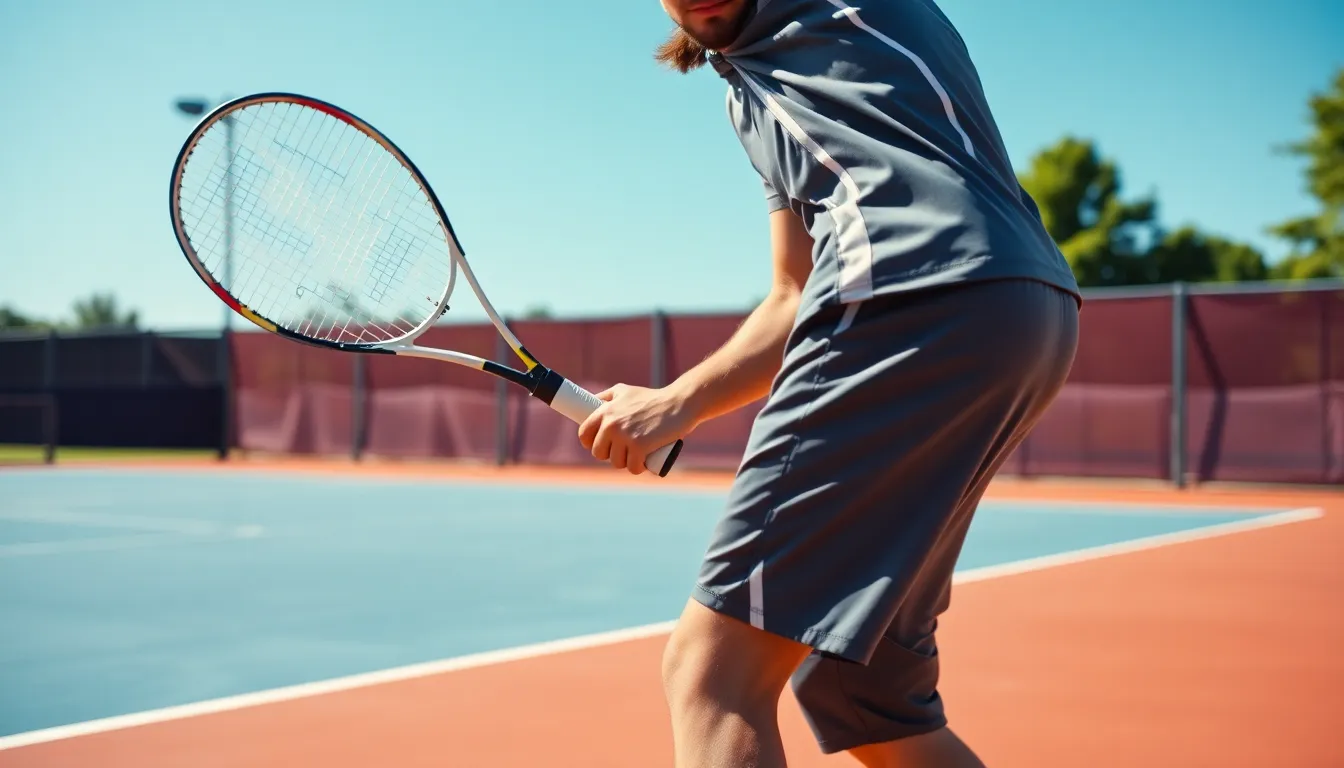
Equipment choices significantly impact your tennis performance and development. The right gear provides the foundation for skill progression and comfort on the court, allowing you to focus on technique rather than equipment limitations.
Choosing the Right Racket
Racket selection directly affects your playing style, comfort, and shot execution capabilities. Beginners benefit from lightweight rackets with larger head sizes (oversize rackets) that offer expanded sweet spots and more power with less effort. Intermediate players should transition to midplus rackets with moderately heavier frames that provide a balance of power and control as skills develop. Advanced players perform best with midplus to midsize rackets featuring heavier frames designed for enhanced control, feel, and precision during complex shot execution.
“I’ve seen remarkable improvements when players use rackets that match their current skill level rather than aspirational models,” notes Azura Victoria. “A beginner using a professional-level racket often struggles unnecessarily, while the right beginner racket can accelerate their learning curve dramatically.”
Recommended rackets by skill level:
| Skill Level | Recommended Rackets | Key Features |
|---|---|---|
| Beginner | Wilson Ultra or Triad series | Lightweight, larger head size, forgiving |
| Intermediate | Wilson Clash or Blade | Medium weight, midplus head, balanced control and power |
| Advanced | Wilson Blade or Pro models | Heavier frame, midsize to midplus head, precision-focused |
Proper Footwear and Apparel
Tennis-exact shoes provide essential lateral stability, court grip, and cushioning that general athletic footwear lacks. Your shoes must support quick directional changes, sudden stops, and explosive movements while preventing ankle injuries and offering durability against court abrasion. Comfort features like breathable uppers and cushioned insoles prevent blisters and foot fatigue during longer sessions.
Appropriate tennis apparel enhances performance through moisture-wicking fabrics that regulate body temperature and allow unrestricted movement. Lightweight, stretchy materials prevent distraction and discomfort during play, particularly in varying weather conditions. Layering options accommodate temperature changes during outdoor sessions.
“Tennis involves so much lateral movement that regular running shoes break down quickly and increase injury risk,” Azura explains. “I’ve coached players who transformed their footwork simply by switching to proper tennis shoes with the right support structure.”
- Moisture-wicking fabrics to manage sweat during intense rallies
- Stretch materials for unrestricted shoulder rotation on serves
- Compression elements for muscle support during long matches
- UV protection for outdoor court sessions
Working with Tennis Coaches and Hitting Partners
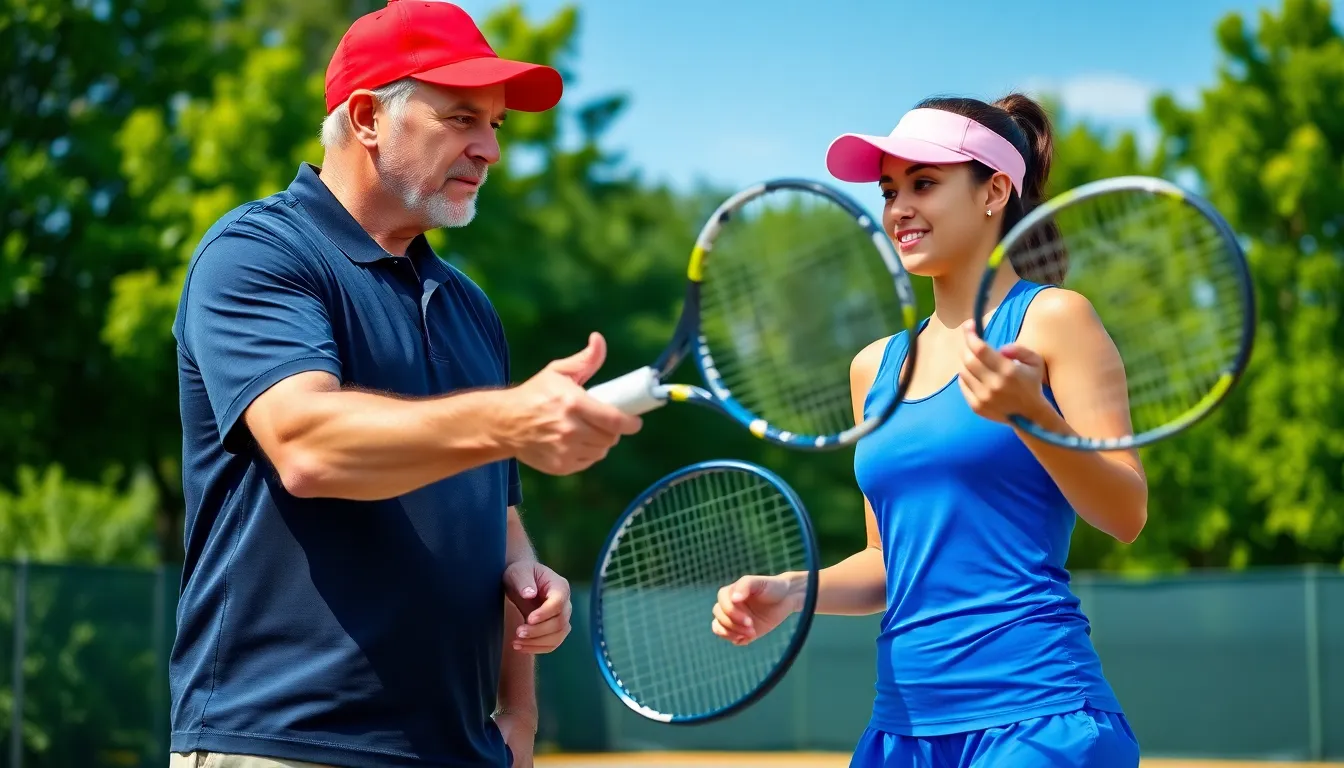
Collaborating effectively with coaches and hitting partners accelerates your tennis development significantly. The right guidance combined with quality practice creates a foundation for rapid skill acquisition and performance improvement.
Finding the Right Coach for Your Level
The perfect tennis coach matches both your current abilities and communication preferences. Coaches should respect your goals while providing instruction that challenges you appropriately. “I’ve seen dramatic improvements when players find coaches who truly understand their learning style,” shares Azura Victoria, founder of tennisservetypes.com. Look for professionals who tailor training sessions to address your exact weaknesses rather than applying generic drills. A coach suited to your level creates progressive challenges that build confidence while expanding your skills. Consider scheduling trial lessons with several instructors before committing to ensure compatibility with your tennis journey.
Maximizing Practice Sessions
Quality practice trumps quantity every time in tennis improvement. Focus on “perfect practice” by incorporating structured drills that target exact skills rather than casual hitting. Develop sessions that balance technical work (stroke mechanics, footwork patterns) with tactical elements (court positioning, shot selection). Azura explains, “My most successful students divide their practice time into focused segments—20 minutes on serves, 15 on volleys, then exact situational drills.” Avoid relying exclusively on match play for improvement; competitive pressure often reinforces existing habits rather than building new skills. Instead, create practice routines that isolate weaknesses in a pressure-free environment. Regular video analysis provides objective feedback that complements your coach’s observations, highlighting improvements and persistent issues that require attention.
Analyzing Your Game
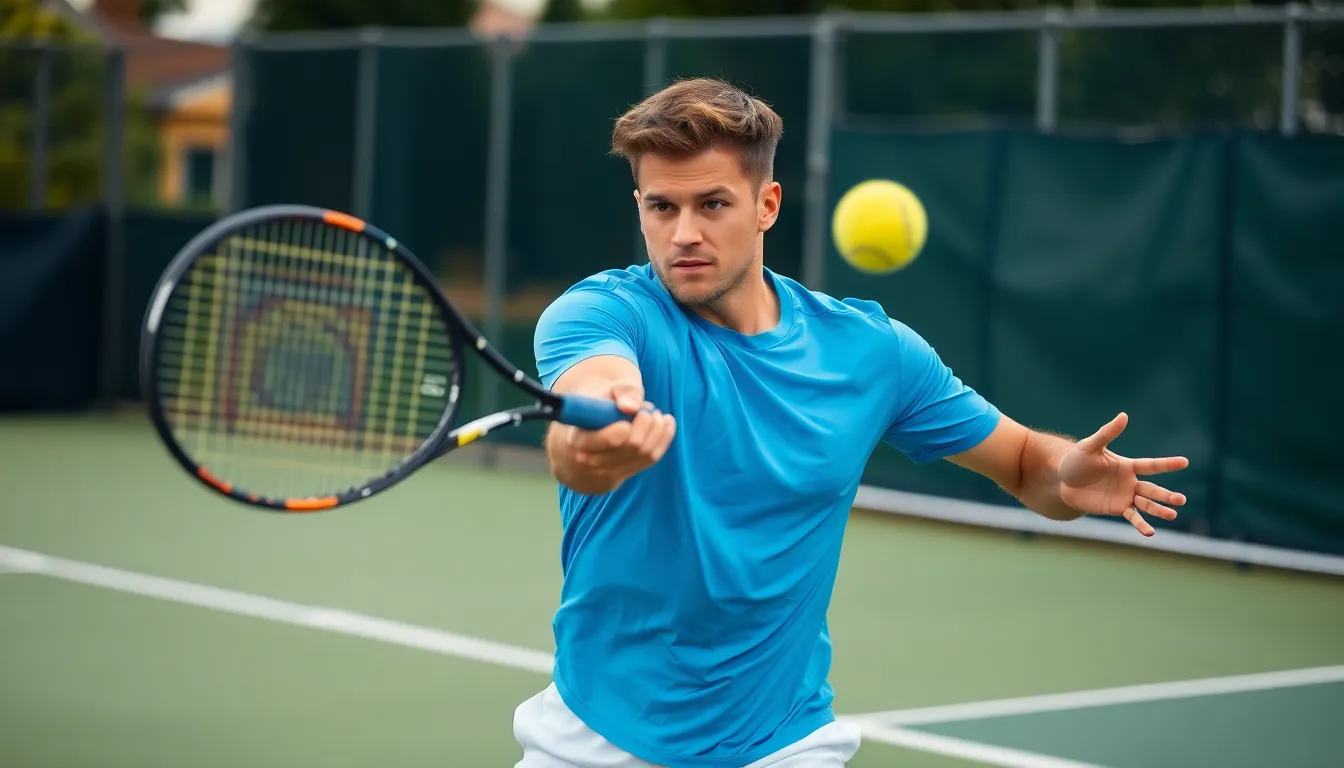
Understanding your strengths and weaknesses creates the foundation for tennis improvement. By systematically evaluating your performance, you’ll identify exact areas to target in practice and develop a more strategic approach to matches.
Using Video Analysis
Video analysis transforms how you perceive your tennis game by revealing technical flaws invisible during play. Set up a camera at both baseline and sideline positions to capture clear footage of your entire performance from multiple angles. When reviewing recordings, focus on exact elements like footwork patterns, grip consistency, stroke mechanics, and tactical decisions during points.
Slow-motion replay apps enhance this process by breaking down complex movements into digestible segments, allowing you to see precisely where your technique differs from ideal form. “My students often experience ‘aha’ moments when watching themselves on video,” shares Azura Victoria. “One collegiate player I coached couldn’t understand why his backhand lacked power until he saw his weight transfer was completely off. After three sessions of video-guided practice, his backhand became a weapon rather than a liability.”
Make video review a regular practice by recording at least one session monthly and comparing footage over time to track improvements. This self-coaching method accelerates development by providing objective feedback that complements your subjective experience on court.
Tracking Performance Metrics
Performance metrics provide concrete evidence of progress and highlight exact areas needing attention. First-serve percentage stands as perhaps the most critical statistic to track, as it directly impacts point outcomes. Record this alongside metrics like unforced errors, winners, net points won, and break point conversion rates during practice sessions and matches.
Azura recommends creating a simple spreadsheet or using a tennis-exact app to log these numbers after each session. “I’ve seen dramatic improvements when players become data-driven,” she notes. “A recreational player I worked with increased her first-serve percentage from 42% to 63% in eight weeks simply by having the awareness that comes from consistent tracking.”
Beyond numbers, track qualitative patterns in your game—situations where you consistently make good or poor decisions, emotional responses that affect performance, and tactical adjustments that prove successful against exact opponents. Compare these metrics weekly to identify trends and establish clear, measurable goals for improvement.
Practice serving to your opponent’s weaker side (typically their backhand) to develop match-winning patterns. Dedicated players benefit from hitting 100 serves daily to build consistency and effectiveness under pressure. Pay equal attention to movement efficiency, focusing on recovery positioning that allows you to reach the next ball with minimal wasted energy.
Advanced Tactics to Elevate Your Game

Advanced tennis tactics transform good players into great competitors. These sophisticated approaches go beyond basic stroke mechanics and incorporate strategic thinking, pattern recognition, and tactical versatility that can disrupt your opponent’s game plan.
Developing a Strategic Game Plan
Strategic game planning creates a roadmap for match success based on your unique playing style. Start by identifying your strengths and weaknesses through honest self-assessment or video analysis. Players with powerful forehands should structure points to set up opportunities for this shot, while those with exceptional court coverage might adopt a more defensive strategy.
“I’ve coached players who transformed their results simply by embracing their natural game style instead of copying professionals,” shares Azura Victoria. “One of my students struggled until we built a game plan around her slice backhand and net play—suddenly she started winning against opponents who previously dominated her.”
Playing to your strengths doesn’t mean ignoring weaknesses. Incorporate practice sessions that address vulnerable areas while designing match strategies that minimize their exposure. Tennis matches often become a battle of who can impose their preferred patterns of play more effectively.
Consider court conditions when developing your strategy. Clay courts reward patience and consistency, while faster surfaces like grass favor aggressive play and net approaches. Adapting your game plan to the surface gives you an immediate tactical advantage against less versatile opponents.
Reading Your Opponent’s Weaknesses
Targeting opponent weaknesses creates immediate scoring opportunities. Watch your opponent during warm-up to identify technical limitations—a cramped backhand, weak overhead, or hesitant volleys offer clues about vulnerabilities you can exploit.
Shot depth serves as a powerful tactical weapon against any opponent. Deep shots reduce attacking options by pushing players away from the baseline, limiting their angles and forcing defensive responses. Even professional players struggle when consistently pushed back from their preferred court position.
“Consistency breaks players faster than flashy winners,” explains Azura. “I recall watching a recreational tournament where one player simply directed 80% of his shots to his opponent’s backhand. Nothing fancy—just relentless targeting that eventually caused complete frustration and collapse.”
Movement patterns reveal additional weaknesses. Players who recover slowly after wide balls create opportunities for you to change directions and exploit open court space. Those with limited lateral speed become vulnerable to shots that force side-to-side movement rather than forward-backward transitions.
Track your opponent’s decision-making under pressure. Many recreational players demonstrate predictable tendencies when stressed—such as always going crosscourt on important points or attempting low-percentage shots when behind. Recognizing these patterns allows you to position yourself advantageously and anticipate their next move.
Tactical variety prevents adaptation. While repeatedly attacking a weakness proves effective, occasionally surprising your opponent with unexpected shot selections keeps them off-balance and prevents adjustment. This strategic unpredictability creates frustration and forces errors even from technically sound opponents.
Advanced shot selection like tweeners, slices, and inside-out forehands expands your tactical arsenal. These specialized techniques allow you to handle difficult court positions and create unique attacking angles. Mastering the backhand slice particularly helps disrupt opponents’ rhythm and transition from defense to offense.
Court positioning communicates intention to observant opponents. Adjusting your stance slightly based on what you plan to do gives away strategic information. Learning to disguise your intentions through consistent positioning regardless of your planned shot direction creates important competitive advantage at higher playing levels.
Conclusion
Becoming a better tennis player isn’t about overnight transformation but consistent dedication to improvement across multiple areas. By focusing on fundamental techniques while gradually incorporating advanced tactics you’ll see meaningful progress in your game.
Remember that physical fitness complements technical skills while mental resilience often determines match outcomes. The right equipment and quality coaching accelerate your development while strategic gameplay elevates you beyond mere shot-making.
Most importantly maintain patience throughout your tennis journey. Track your progress celebrate small victories and enjoy the process. With the strategies outlined in this guide you’re well-equipped to take your tennis abilities to new heights. Now grab your racket and put these principles into practice on the court!
Frequently Asked Questions
How often should I practice to improve my tennis skills?
For significant improvement, aim to practice 3-4 times per week, with each session lasting 1-2 hours. Consistency is more important than marathon sessions. Include a mix of technical drills, tactical play, and physical conditioning. Even 20-30 minute focused practice sessions can be beneficial if you can’t commit to longer ones. Remember that quality practice with specific goals will yield better results than unfocused hitting.
What are the four essential tennis strokes beginners should master?
The four essential strokes are forehand, backhand, serve, and volley. The forehand is typically hit with your dominant hand, while the backhand can be one-handed or two-handed. The serve initiates every point and can be a powerful weapon when developed properly. The volley is executed near the net without letting the ball bounce. Mastering these fundamentals creates the foundation for all advanced techniques.
How important is footwork in tennis?
Footwork is absolutely crucial in tennis—perhaps the most underrated skill. Good footwork allows you to reach more balls, maintain balance during shots, and recover quickly between points. It enables proper positioning for each stroke, generating more power and consistency. Even players with excellent stroke technique will struggle without proper footwork. Dedicated footwork drills should be a regular part of your practice routine.
What physical training should tennis players focus on?
Tennis players should focus on a balanced program including cardiovascular endurance, strength training, agility, and flexibility. Prioritize core strength, leg power, and rotational exercises that mimic tennis movements. Include lateral movement drills, sprint intervals, and medicine ball throws. Shoulder and forearm strengthening helps prevent injuries. For best results, aim for 2-3 strength sessions and 2-3 cardio workouts weekly, adjusting based on your match and practice schedule.
How can I improve my mental game in tennis?
Improve your mental game by practicing visualization techniques, developing pre-point routines, and establishing breathing patterns to manage stress. Work on staying present—focus only on the current point rather than past mistakes or future outcomes. Keep a tennis journal to track mental patterns. Practice playing pressure points during training to build resilience. Remember that mental toughness is a skill that improves with deliberate practice just like technical skills.
What should I look for when choosing a tennis racket?
When choosing a tennis racket, consider your skill level, playing style, and physical attributes. Key factors include head size (larger for beginners, smaller for advanced players), weight (heavier rackets offer more power but less maneuverability), balance, string pattern, and grip size. Test several rackets before purchasing. Most intermediate players benefit from medium-weight rackets (10-11 oz) with mid-plus head sizes (95-105 sq inches).
How can I read my opponent’s weaknesses during a match?
Observe your opponent during warm-up and early games. Watch for technical limitations (weaker backhand, hesitant net play), movement patterns (slower to one side), and situational weaknesses (struggling with high balls or slice). Notice emotional reactions to errors and pressure points. Test different shots and strategies early in the match. Keep mental notes of which shots earned you points and patterns that cause your opponent difficulty.
Is it worth hiring a tennis coach?
Absolutely. A qualified coach provides expert feedback on technique, personalized training plans, and objective assessment of your strengths and weaknesses. Coaches spot flaws you may not notice and accelerate improvement by providing structured progression. Even a few sessions can significantly improve specific aspects of your game. For best results, find a coach whose teaching style matches your learning preferences and clearly communicate your goals.
How can I develop more consistency in my strokes?
Develop consistency by prioritizing control over power during practice. Focus on proper technique, maintaining a stable stance, and developing a compact swing. Practice hitting to large targets at moderate pace before attempting more aggressive shots. Incorporate shadow swings to reinforce muscle memory. Use ball machines or consistent hitting partners for repetitive practice. Track your consistency metrics during practice to monitor improvement over time.
What’s the best way to improve my tennis serve?
Break down your serve into components: grip, stance, toss, loading, contact, and follow-through. Practice each element separately before combining them. Start with slow, deliberate serves focusing on accuracy before adding power. Use targets in service boxes during practice. Film yourself to identify technical issues. Dedicate at least 20-30% of your practice time to serving, as it’s the only shot completely under your control and begins every point.


